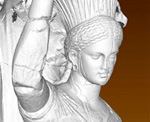Jean-Luc Martinez, an archaeologist with the Musée du Louvre, asked the INSIGHT team to help document and reconstruct a fragmentary column from the Temple of Apollo at Delphi, Greece. The goal of the reconstruction was to validate Martinez’ hypothesis that the Omphalos (a well-known sculpture meant to mark the ‘center’ of the Hellenic world) once rested atop the dancers’ column. As the column is now in pieces, the INSIGHT team was faced with the monumental task of capturing dozens of individual fragments while maintaining exceptionally high detail in the resulting data.
Overview
The INSIGHT data presented here is detailed in a technical paper presented at the 5th International Symposium on Virtual Reality, Archaeology and Cultural Heritage (K. Cain, Y. Chrysanthou, F. Niccolucci, N. Silberman Editors): A Point-Based Approach for Capture, Display and Illustration of Very Complex Archeological Artefacts (Florent Duguet, George Drettakis, Daniel Girardeau-Montaut, Jean-Luc Martinez, Francis Schmitt).
Guillaume Thibault and Jean-Luc Martinez also contributed a chapter titled La reconstitution de la colonne des danseuses de Delphes to the book Actes du Colloque Virtual Retrospect 2007(Vergnieux, R. and Delevoie, C. Editors), which makes extensive use of the INSIGHT data.
3D Scanning and Post Processing
3D capture for archaeological objects has become a routine research tool for many groups around the world. While the process remains relatively expensive, it is possible for well-trained teams to produce good quality results for modestly sized objects using close-range scanners. It is equally possible to do the same for whole sites, creating solid results (at slightly diminished resolution and accuracy) with long-range scanning hardwar. This equipment has become robust, user-firiendly, and even (depending on your location) ubiquitous.
Artifacts such as the Delphi Acanthus column, however, fall in a no-man’s land between close-range and long-range capture. As with similarly scaled sculpture documentation projects (notably, Dr. Marc Levoy’s Digital Michelangelo Project), we decided to use close-range optical triangulation scanning. This necessarily led to the production of many thousands of individual scans, as the quality of optical triangulation techniques diminishes with distance.
Guillaume Thibault wished to maintain high accuracy in the data, so that archaeologists could clearly see potential connections between pieces. In particular, the ‘unwrapped’ point visualizations Thibault wished to create (see above, right) are highly sensitive to outliers and noise. (The dark gray area seen in the center of the image is one such artifact, where sub-millimetric disagreements between point sets are easily seen.) Typically, a single isosurface is extracted from a group of point clouds, resolving any conflict between onion skin layers of scan data; but in this case Thibault was developing a point cloud viewer without familiar front surface culling. Therefore, high accuracy was an absolute requirement and was defined in the following way: each point in the data set was required to fall within the implicit surface defined by the set of all points, to an accuracy of less than one millimeter. This is not the same thing as imposing a requirement that all scans have one millimeter accuracy — it’s a much stronger criteria. Each of the thousands of individual scans was required to align with all its neighbors to within single millimeter accuracy. One strategy to accommodate this kind of requirement is simply to bend each scan as needed during the alignment phase. Non-rigid alignment techniques guarantee alignment locally, but since they do not increase accuracy, we decided against that appproach.
Instead, we worked with Youda He of Geometry Systems to create a new technique for aligning point clouds. In most approaches to iterative closest point alignment, the goal is to minimize the distance between representative points in each point cloud being aligned. When iterating over each cloud in a large group, the global result is that well-aligned clouds are drawn together. However, this necessarily causes gaps between those clouds with poor alignment. As closing these ‘clamshell’ gaps is required in order to maintain high quality alignment, we implemented a variant of ICP where the the routine maximizes, rather than minimizes, the error between pairs. Provided that the initial alignment was relatively good, we found that the maximum error ICP approach will efficiently close ‘clamshell’ regions of poor alignment and eventually converge to a highly coherent alignment. This key innovation made it possible for us to register thousands of scans in the data set while maintaining the extremely high quality noted above. Importantly, the maximum error ICP was not all that was required. Hundreds of hours of manual point cleaning and carefully choreographed grouping of aligned regions were required, as well as section traversal tools to quickly identify alignment errors in point clouds.
Once the point clouds from all the constituent objects had been successfully aligned, it was now possible to test Jean-Luc Martinez’ theory. Moving the Omphalos into place above the dancers (see below), the placement and proportion of the two sculptures was greeted favorably by Martinez and his team. In addition to the value of testing this theory, the project also provided the data needed to visualize and notate the objects themselves. Archaeologists had been attempting an accurate drawing of the complex Omphalos for many years; by unwrapping the 3D scan data into a plane, an accurate drawing was at last possible (see above).
A range of visualizations were made from the final aligned data sets. Florent Duguet and George Drettakis rendered the images above and below. Many more examples are contained in the papers noted at the top of this page.
